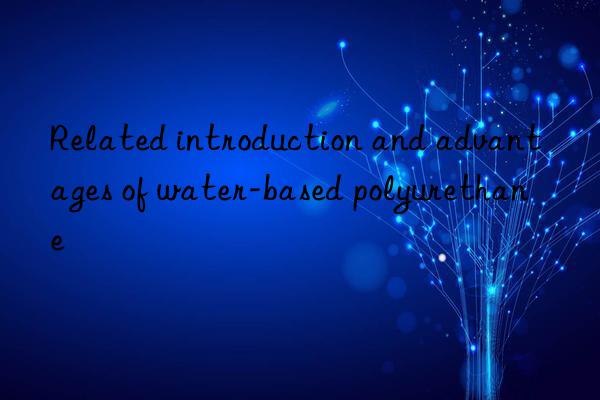
Polyurethane fromIt began to develop in the 1930s, and the research on water-based polyurethane began in the 1940s. In 1942, P. Schlack of Germany successfully developed a polyurethane emulsion by dispersing diisocyanate in water and adding diamine through vigorous stirring in the presence of emulsifier and protective glue. In 1953, Wyandott of DuPont Company dispersed the toluene solution of diisocyanate group-terminated polyurethane prepolymer in water, extended the chain with diamine, and then added an appropriate emulsifier to form a polyurethane emulsion under the action of strong shear force. However, this process is difficult to meet application requirements due to the large amount of emulsifier, long reaction time, and coarse emulsion particles, resulting in poor stability, poor film-forming properties, and poor coating performance.
Because polyurethane material science had just started at that time, water-based polyurethane did not receive enough attention, and there was not much progress in the research process and production. It was not until 1967 that water-based polyurethane appeared in the U.S. market in an industrialized form for the first time. In 1972, Bayer Company officially mass-produced polyurethane water dispersion as a leather coating. In the 1970s and 1980s, some polyurethane emulsion products in the United States, Germany, Japan and other countries developed from the trial production stage to industrial production and application, and various brands of polyurethane emulsion products began to be supplied.
Before 1962, the polyisocyanate used in water-based polyurethane was almost all TDI. This material has many advantages such as good comprehensive performance, large output, many varieties, wide application, and low price, but there is a serious problem. Disadvantages: Poor resistance to yellowing. Aliphatic polyisocyanates such as IPDI and HDI that emerged later have overcome this shortcoming, but the cost is higher. Today, when there are no special requirements for yellowing resistance, TDI is still used as the main polyisocyanate raw material.
Because the polyurethane structure has soft and hard blocks, and the soft and hard blocks are adjustable, by adjusting the structure, the resulting material has the following advantages.
① Strong wear resistance and adhesion.
② Excellent anti-corrosion performance, resistant to oil, acid, alkali and salt, and industrial waste gas.
③The construction temperature range is wide, from low temperature to room temperature to thermal curing temperature.
④ It has excellent electrical properties.
⑤ Good mixability with a variety of resins.
⑥Good decoration and protection properties.
⑦ Good resistance to high and low temperatures, with corresponding varieties available at -40~300℃.
Because early solvent-based polyurethane materials contained toxic solvents, they seriously polluted the environment and harmed human health. As the quality of human life improves and environmental regulations become more and more stringent, various environmental regulations have strict regulations on the emission of volatile organic compounds (VOC) and the content of harmful solvents. Strict restrictions. Because water-based polyurethane uses water as the dispersion medium, it not only has the advantages of being non-toxic, not easy to burn, not polluting the environment, energy-saving, safe and reliable, but also has some important performance characteristics of solvent-based polyurethane. Water-based polyurethane materials not only have good comprehensive performance, but also have the characteristics of non-pollution, safe transportation and good working environment, which meet the environmental protection requirements. What is even more attractive is its low price. It maintains the performance of organic solvent-based products without basically changing the organic solvent-based use process, and is cheap and safe. Therefore, water-based polyurethane materials are a type of water-based materials that have developed rapidly in recent years.
Water-based polyurethane materials have excellent flexibility, mechanical strength, wear resistance, adhesion, chemical resistance and durability. Europe, the United States, and Japan regard them as high-performance varieties. R&D.
In comparison, China's water-based polyurethane is still in the preliminary development stage, and market expansion still takes time. The output of the product is far from meeting the large market demand. In addition, domestic water-based polyurethane Polyurethane still has many defects and room for improvement in many aspects, such as poor water resistance, short storage period, low molecular weight, low resin content in the emulsion, and large batch product differences. Therefore, research on the application and modification of water-based polyurethane It has become a research hotspot for relevant domestic enterprises and university researchers.



 微信扫一扫打赏
微信扫一扫打赏
